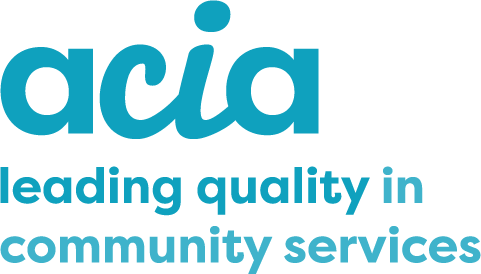Tips for working safely
Introduction: Tips for working safely
This section inlcudes tips for working safely.
It's what all Support Workers need to know.
If you want to test you knowledge do the Safe working Self-assessment.
If you want an overview of what makes for good attendant care see:
Getting Attendant Care Right on the companion web site Living with Attendant Care
Movements
Your body is your work tool. Take care of it.
Your job is very physical and it is hard to do your duties if injured.
Some injuries never heal. Take care and be safe.
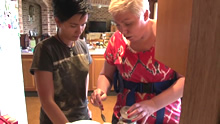
Support Worker and Participant
Did you know
-
Manual handling is pushing, pulling, lifting, moving, carrying, grasping or holding an object, person or animal.
-
To keep a neutral spine as much as possible and avoid forward, backward or side bending as well as twisting of the spine.
-
When you lift while twisting you can not only hurt your low back but your knees too.
-
Your thigh and buttocks muscles are some of the biggest and strongest muscles in the body.
-
Transfer belts are not lifting devices even though they have handles.
Have you considered?
What’s a better way?
-
Is the object awkward or heavy to move? What could change?
-
Does the task make you work in awkward postures; make you hold postures for a long time or frequently repeat postures?
-
Alternate tasks and positions so you don’t become fatigued in one area of your body and to reduce the likelihood of injury.
-
Can the process be done easier?
Do you
-
Kneel on one knee instead of two to help keep your spine neutral?
-
Avoid twisting the neck and spine as much as possible?
-
Have your entire body directly face the task in order to avoid twisting the neck, back or knees?
-
Avoid over reaching by staying close to the task?
-
Reduce the forces through your low back by staying close to the task?
-
Use your leg and buttocks muscles versus your back muscles when you can in order to help keep your back safe?
-
Move in a controlled and easy pace especially if moving a Participant?
-
Know that Participants should not hold you to pull themselves up?
-
Know that in general, and with the exception of very small children, you shouldn't move most or all of a person’s body weight without assistance of equipment and/or a second person to lighten the load?
-
Maintain healthy sleep patterns? Fatigue often leads to injury.
-
Maintain your health and fitness? You have a physical job.
Completing tasks

Support Worker and Participant
Are you well trained?
-
Have you been trained in the use of the equipment?
-
Have you been trained in the necessary behaviour management?
-
Do you know the falls prevention or management policy or plan?
-
Are you qualified to perform the task, e.g. tracheostomy care, ventilator management, bowel care, swallowing disorder care?
-
Do you know the correct procedures for the tasks you are being asked to perform?
-
Do you need to buddy up with a co-worker until you learn the service activities and correct procedures for specific tasks?
Do you
-
Talk to your Participants in a calm and friendly voice even if you don’t think they understand? Doing so can go very far in putting them at ease.
-
Communicate with others in the service to let them know what you are going to do and when?
-
Get stuck in your ways of doing things just because you’ve always done it one way? Be open to different ideas and methods. You may learn a way that is easier, quicker or safer.
-
Prepare before you do a task? An organised worker is a more effective worker.
-
Have you ever been in a hoist? It can be frightening for some people.
Have you considered?
What’s a better way
-
Are you lifting or holding the Participant up?
-
Do you think you need more or different equipment?
-
Do you feel you need more time to complete the service?
-
Has the Participant decreased their ability to help?
-
Are other team members having difficulty with the service?
-
Is the bed too wide?
-
Does the bed adjust high and low?
-
Are you sore after completing a task?
-
Do you try to avoid a particular service?
-
Do you think equipment might make the task easier or safer?
-
Do you think a second care worker might make the task easier or safer?
-
Is the Participant able to assist more at certain times of day?
-
Has the Participant’s condition declined? If so, is it an abrupt decline or gradual? Does the Participant need medical attention?
-
Are cleaning chemicals in their original container?
In the home
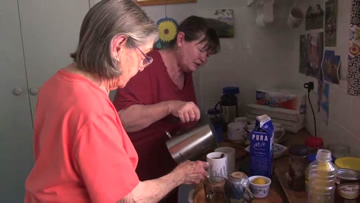
Family member and Support Worker
Do you
-
Do you have your phone, car keys with you and shoes on during the entire service in the event you need to abruptly leave?
-
Do you have an emergency response plan?
-
Do you have a behaviour management plan and now how to implement it as needed?
Have you noticed any of the following?
So what do you need to do?
-
Is clutter or furniture getting in your way to doing the tasks?
-
Is the space so confined that you need to twist or over reach to complete your task?
-
Is it too dark to see where you are walking and what you are doing?
-
Is it too hot and humid due to heaters or no open windows?
-
Is the flooring in disrepair?
-
Are the electrical cords frayed? Do you have a portable Residual Current Device (RCD) safety switch?
-
Is the equipment in good working order?
-
Are there pets around during the service that may bite or get under foot and cause you to trip?
-
Is there smoking, alcohol or illicit drug use during the service?
-
Are there individuals or animals present that have you concerned for your safety or that of the Participant?
In the community
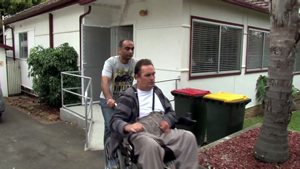
Support Worker and Participant
Do you
-
Do you have a check in system so others can anticipate where you should be in the event you are running late or if there are other concerns?
-
Plan for the safety considerations of a specific neighbourhood or area you will be in?
-
Do you have an emergency response plan for when you are alone or with a Participant?
-
Do you have a behaviour management plan and now how to implement it as needed?
-
Anticipate the needs, equipment and accessories the Participant may need while with you in the community?
-
Think of safety concerns for both day and night services as well as time of day and locations you will start and finish?
Have you noticed any of the following?
So what do you need to do?
-
Is there ample lighting to, from or around the home or other location you are walking to and from?
-
Do you feel unsafe?
-
Do you have long waits for public transport?
-
Are there individuals or animals present that have you concerned for your safety or that of the Participant?
-
Is the pedestrian area confusing or does it have potentially dangerous vehicle areas?
Driving
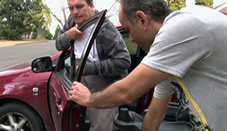
Participant and Support Worker
Do you
-
Do you have a check in system so others can anticipate where you should be in the event you are running late or if there are other concerns?
-
If running late, phone ahead to let Participants and service coordinators know instead of being stressed and taking chances while driving?
-
Do you have a roadside assistance plan in the event of breakdown?
-
Do you have a first aid kit to manage basic injuries?
Have you noticed any of the following?
So what do you need to do?
-
Is there ample parking?
-
Is the parking close enough to the location you or you and your Participant are going to?
-
Are there traffic safety concerns when getting you or Participant out of vehicle?
-
Will the Participant be safe if you drop them off and then go park the vehicle?
Are these everyday practices for you?
-
Obey the road laws.
-
Pull your vehicle over into a safe parking spot and turn off the vehicle to answer phone calls, texts, set your navigator, etc. i.e. Don’t drive distracted by texts, eating, phone calls.
-
Give yourself ample time between services to compensate for traffic congestion.
-
If driving in remote locations, plan where network blackout locations will be and check in before and after going through them.
-
Plan for the weather and related driving conditions. Make provisions for potential breakdown in hot or cold weather and for increased travel time due to rain or icy conditions.
-
Avoid fatigue while driving.
-
Adjust your seat for increased comfort and maintaining a neutral spine.
-
Adjust your mirrors to increase visibility.
-
Adjust your interior temperature to avoid fatigue.
-
Are you able to meet the Participant’s needs while driving?
-
Does the Participant distract you too much when driving?


